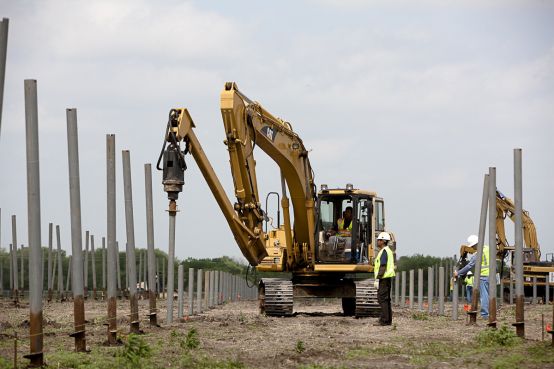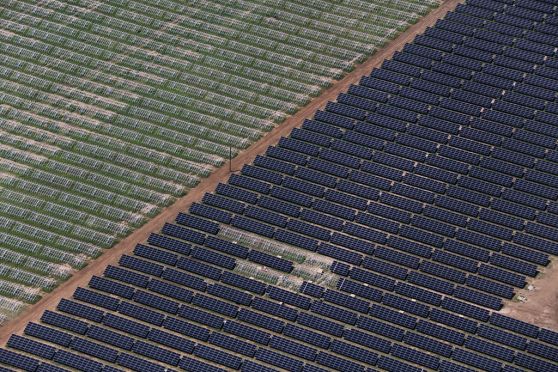Recently, in what is destined to be a long series of profiles of solar projects larger than ten megawatts, we looked at Agile Energy's efforts to develop a 50-megawatt project in Ohio called Turning Point Solar. That project is still in the development stage. This week, we look at Blue Wing.
The Blue Wing solar farm near San Antonio, Texas is operational and producing 16.6 megawatts of DC power (14.4 megawatts AC). It's the largest solar photovoltaic (PV) facility in Texas and the third largest PV farm in the U.S. The amount of generation from the facility is approximately 25,000 megawatt-hours.
The installation includes a 500-kilowatt demonstration facility where an assortment of thin film and crystalline silicon PV modules as well as a concentrating PV unit have been installed for research and comparison purposes. The project developer did not divulge the CPV vendor (although we're looking into that).
Juwi solar, with U.S. operations based out of Boulder, Colorado, developed, designed and built Blue Wing. The project is owned by Duke Energy and the power is purchased by CPS Energy under a 30-year power purchase agreement. To date, juwi solar had developed and built three of the largest solar power plants in the nation: the 15-megawatt Jacksonville Solar in Florida, the 12-megawatt Wyandot Solar in Ohio, and the 16-megawatt Blue Wing.
-
Where Will DOE’s Loan Program Make the Next Climate Tech Investments?
48
-
What the Frack Is Happening With Natural Gas Prices?
15
-
With an Energy Crisis Brewing, No Peak in Sight for Emissions
9
Here are some of the vital statistics of the Blue Wing project:
- Quantity of First Solar modules: 223,900 (includes demo; 214,500 First Solar)
- Quantity of Racks: 4,444 on about 12,000 rack posts
- Quantity of SMA inverters: 22
- Road Length: 6,684 feet
- Fence Length: 12,450 feet
- Power: 16,087,500 watts DC plus 618,720 watts DC for the demo
- Acreage: 113 (project), 140 (site)
- Array Tilt: 20 degrees, Array Azimuth 25 degrees west of south
- 200 ground rods and over 100,000 ft. of ground cable.
- 24 lightning poles distributed around the site to collect lightning strikes
- Construction began in March 2010
- During construction peak there were 115 workers at the site. More than 100,000 labor-hours of construction work was generated.
- Approximately $2,000,000 in local purchases were made during construction.
I interviewed juwi solar Managing Director Michael Martin. In Martin's words, Blue Wing is "truly a utility-scale project" in that it has a “leading [commercial business unit of an] investor-owned utility in DEGS and a leading utility power purchaser in CPS Energy." Martin continued, "What we're seeing this year is 250 megawatts to 400 megawatts of true utility-scale solar in the U.S." He added, "This amount of megawatts is still insignificant in the global picture but it's a great sign as a start."
Martin said that there are "a lot of [project] announcements but fewer announcements of construction -- some announced projects are not going forward." He added that "juwi, First Solar and SunPower are the only folks to have built operational utility-scale solar projects." (SunPower has DeSoto, Nellis AFB, Space Coast and Exelon at 27 MW, 14 MW, 11.5 MW and 10 MW, respectively, while First Solar has Blythe and El Dorado at 24 MW and 10 MW, respectively.)
Martin said that one of the reasons that First Solar panels are being used at this site is because the temperature coefficient and the ability to capture diffuse light of the cadmium telluride-based panels is better suited to the Texas heat and sun. Martin added that those factors, coupled with First Solar's cost-effectiveness, allowed the "power purchase price to be lower and the banks to be happier."
On this Blue Wing site, the environmental impact report was not a problem, nor were there any archeological issues. This is not an issue to take lightly, as tortoises, Native American burial grounds and foxes have slowed or halted progress on many solar projects in the past.
In some solar projects, the project developer and engineering, procurement and construction contractor (EPC) are different parties. In juwi's case, it's typical for them to be the developer and the EPC, as well as to perform the ongoing O&M (operations and maintenance). Juwi's business is to build projects cost effectively -- and ultimately, the owners and utilities benefit from "not having too many hands in the pot," according to Martin.
Power from solar farms is not quite at grid parity or at the price of a kilowatt-hour from coal. But in Martin's view, "We're starting to see less than 15 cents per kilowatt-hour" going forward in 2011. Given the improved quality of financing for these projects and the declining price of solar modules -- that levelized cost of energy (LCOE) should only improve.


